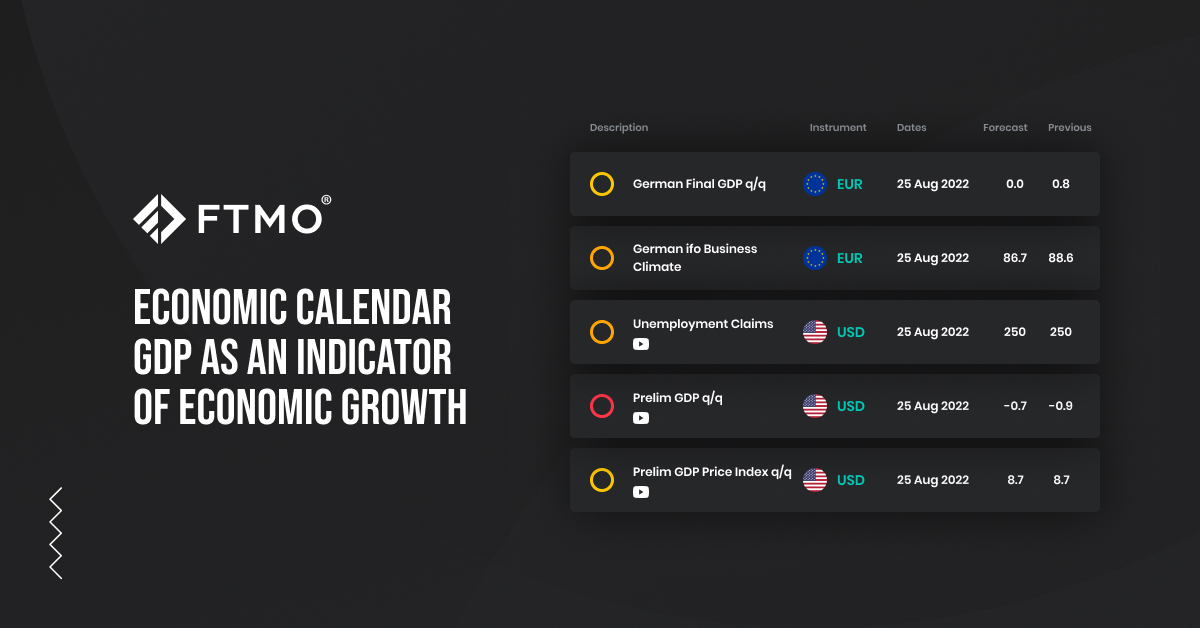
Economic calendar - GDP as an indicator of economic growth
Gross domestic product is an indicator of the health and performance of a country's economy. Although this indicator also has many critics among economists, it definitely has an important place in the economic calendar, and its influence on market events can't be doubted.
GDP can be defined as the total value of goods and services produced in a particular country. Economists often use it as an indicator of the economy's performance and overall state over time. Generally, GDP is measured over the past year, month, or quarter. The figure is also used when comparing different countries in the form of GDP per capita.
In addition to nominal GDP, which is an expression of the value of output without adjustment for inflation, real GDP is also calculated. The latter is adjusted for inflation or deflation and determines whether the economy is growing due to output growth or whether price increases primarily drive growth.
There are several ways of calculating GDP, each considering different aspects. Usually, economists use the production method, the expenditure method, and the income method. The expenditure method is perhaps the most commonly used one. According to the U.S. Bureau of Economic Analysis, responsible for calculating GDP in the U.S., the source data for this calculation is more reliable than the other methods.
According to this method, the formula for calculating GDP looks like this:
GDP = Consumption (C) + Investment (I) + Government Spending (G) + (Exports (X) - Imports (M))
Criticism
Although GDP is considered an indicator of economic performance, and GDP per capita is often used to compare different economies as an indicator of a country's standard of living, it is also confused as a measure of wealth and well-being, which is not entirely accurate. Moreover, GDP does not include several factors affecting the population's standards of living. Author of the concept of GDP, the American economist Simon Kuznets, pointed out that it is necessary to bear in mind the difference between the quantity and the quality of growth and that the measurement of income does not include the effort that goes into achieving it.
According to critics, GDP does not take into account environmental pollution, the health of the population, or the level of education. It also does not consider the political situation and the level of liberty in a country or the differences between rich and poor because it gives average GDP per capita figures. GDP also does not include transactions outside the market (e.g. in the household) or voluntary activity, and of course, it does not include the grey economy and illegal activity.
Economic health indicator
Despite the criticism, GDP remains very closely watched by investors and traders. Its announcement is an essential item in the economic calendar, as its impact on market events can be significant. In particular, the shorter-term data (most often the quarterly figures) are important as they give a more accurate view of where the economy is at the moment. Year-on-year change data, on the other hand, show a longer-term trend.
When GDP is rising in a country, it should typically mean that the economy is doing well. As with other data that investors and traders track on the economic calendar, GDP numbers are usually priced in asset prices, so the actual numbers may not lead to significant market movements. However, when published GDP data are surprisingly good or bad, markets can experience an increase in volatility.
Generally, when actual GDP is above expectations, a country's currency should appreciate and vice versa. GDP numbers that are too high can mean that the economy is at risk of overheating and high inflation, which can lead to rate hikes. Conversely, too low numbers, or even negative numbers indicating a contraction in the economy, lead to a recession, loose monetary policy, and a weakening currency.
Traders and investors must also consider whether the data are preliminary or final. For example, in the US or the eurozone, GDP data are announced up to three times for the previous quarter, and after two preliminary data, the final number is not published until the end of the following quarter (we did not get the final Q1 data in the US until the end of June). Elsewhere in the world, a preliminary figure is usually published first, followed by the final figure right away. If too large and very surprising, the difference between the preliminary data and the final figure can also cause significant short-term movements in the markets.
Even in this respect, however, not everything is always clear-cut, as we can see in the development in 2022. The US economy is technically in recession, as it has already posted a decline in GDP in two consecutive quarters. At the same time, however, inflation is at long-term highs, and the Fed has to tighten monetary policy despite the decline in GDP. And since the political and economic situation is relatively bad worldwide, and the US dollar is considered a relatively safe asset, its value is rising, despite the recession in the US, to record levels.
GDP is an important indicator of the economy that investors and traders should watch closely. Although its values need to be put in context with other macroeconomic data, it is one of the most critical indicators that can significantly impact markets.
About FTMO
FTMO has developed a two-step evaluation process to find trading talents. Upon successful completion, you may be eligible for an FTMO Rewards Account with a balance of up to $200,000 in simulated funds. How does it work?









